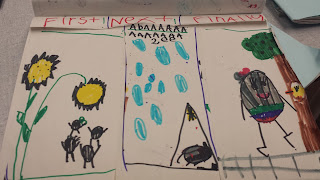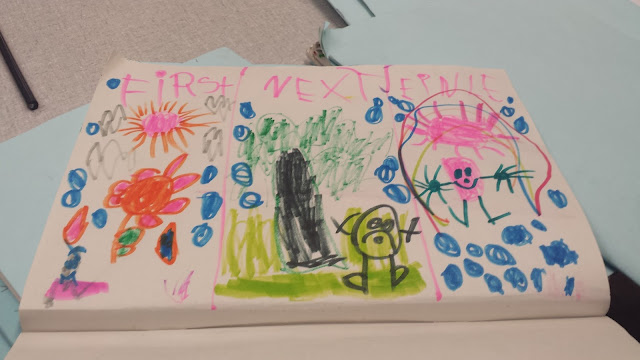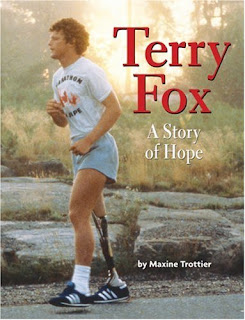Dear Parents,
One of the cornerstones of building successful readers is honing in on oral literacy, so it's one of my goals this year to ensure that students respond to texts frequently and have opportunities to share their thinking and writing.
This has been the part of our literacy program where I've seen students show the most confidence and engagement. Many students in our class love to draw--and it's interesting because they have already shown strong preferences in terms of medium (Skinny markers are more popular than fat markers).
I thought I'd share a number of the books and responses from students so far.
The first book we tried this type of response with was
Where Oliver Fits: It's about a puzzle piece who needs to figure out where he fits. I liked this story especially at the beginning of the year, because our class is also figuring out how we fit together. Students were asked to draw themselves as a puzzle piece and talk about what made them feel safe and happy, like they fit.
 |
| This student talked about playing hockey |
 |
| This student surrounded themselves with animals and nature |
 |
| There is their house and their friends and music here |
 |
| This one is complex: they have their house, their family, nature, and favourite foods |
 |
| This student is showing themselves surrounded by their friends |
 |
| Lots of colours and a heart to show their family |
 |
| This student added names of people who make her feel good |
 |
| This student was thinking about candy |
 |
| All about the music |
 |
| "Dad, Mom, Marissa (my friend) and Hockey" |
 |
| This student wanted to include birds |
The puzzle pieces you see on our display board are a result of students asking to revisit this topic.
The next book we looked at was
The Bad Seed (Link to book trailer video). One of my favourite things about reading this book was that I kept hearing students reading it to themselves using the bad southern accent I affected to say the title. (Small amusements, I know.) I asked students to respond using the words First, Next, and Finally to help them retell the story.
 |
| I am a bad seed/He needs help/He opened the door because he trying to be nice |
 |
| This one is feeling sad at the end because he hears other people calling him a bad seed. |
 |
| This student mixed up the order, but we cut them out and glued the panels back in the correct sequence together |


 |
| He was bad because he got hurt.//That's a bad seed. I heard that. |

 |
| This one only shows the first half of the story: He is growing, he is picked, he gets spit out by someone. |

 |
| In the last frame: "Actually, he's not that bad" |
 |
| I am baaaaad/I am a bad/I am good. |
 |
| Growing/Gets hurt/Starts opening doors |
 |
| First he's bad/tNext we find out he wasn't always bad/Finally, He's s trying to be good |
We read this
Bug Patrol book several times. The first time, students were asked to read the repeating parts along with me. The next time, we focused on noticing rhymes and, the third time, I asked students to tell me their favourite character (and why). As we move through the year, I'll try to deepen their reasoning, but for now, it's important that they're able to identify a character.
Results were fairly evenly split:
 |
| Spiders on bikes, because I like bikes |
 |
| I like spibrs (Spiders) |
 |
| I likd po (I liked the police) |
 |
| I like cop, Woo woo" |
 |
| I like bebs (babies) |
 |
| This student likes the crickets up until dawn 'becos I like to parte" |
 |
| I like the kicrits (crickets) becus they prte (Party) |

 |
| Ants on Donuts |
 |
| I like cool ples (police) |





After our Terry Fox walk, we did a picture reading of this
book (the text is better suited to Grade 3 +) and talked about why Terry Fox was significant.
 |
| Terry Fox is walking on the side of the road asking for money |
 |
| This one is harder to see, but a variety of vignettes from Terry's life and work are included. |
 |
| Terry Fox, cancer, metal leg, running across Canada, Raising money to solve (This student copied our discussion notes) |
 |
Even the foxes like Terry Fox: "He is the guy"
|
 |
| Terry Fox is walking through Toronto |
 |
| People are cheering on Terry Fox (....not sure why sky zone is also included) |
 |
| People are cheering Terry Fox from their cars. |
Jon Klassen's
This is Not My Hat is an instant classic. When reading this book, students were asked to infer what happened to the little fish in the weeds, after the big fish followed him in. The answer is never given in the book, so students need to use their best judgement.
 |
| Here is the little fish swimming into the big fish's mouth |
 |
| The little fish is in the belly, The hat is back on the big fish's head |
 |
| "fish found big fish" |
 |
| "I Do Not Like This", says little fish inside big fish. |
We read two books on Orange Shirt day...the other book was When I Was Eight (We'll come back to it as part of our Social Studies curriculum, this book is a great way to start talking about residential schools) and this book, by Sherman Alexie.
Thunder Boy Jr is about a boy who doesn't like his name. It's important to me that we read books about First Nations people that are more contemporary and show resolvable conflicts.
After reading this book, students were asked to identify the problem and solution. We talked about what these words meant, but this was still a challenging assignment for our students.

 |
| His new name is Lightning |
 |
| I sic is tim to thag yor name = I think it's time to change your name |
 |
| I do not like my name/my new name is litening |
So, responding in pictures is a good way to see what students have absorbed from your read alouds. In our classroom, we're working on identifying features and elements of stories (characters, setting, plot, etc.) and while many students are able to retell a story or plot points, we're also working on asking some bigger questions and being able to respond to them in thoughtful ways, whether through speakings, pictures, or writing.
Sincerely,
Ms. Goegan





































































